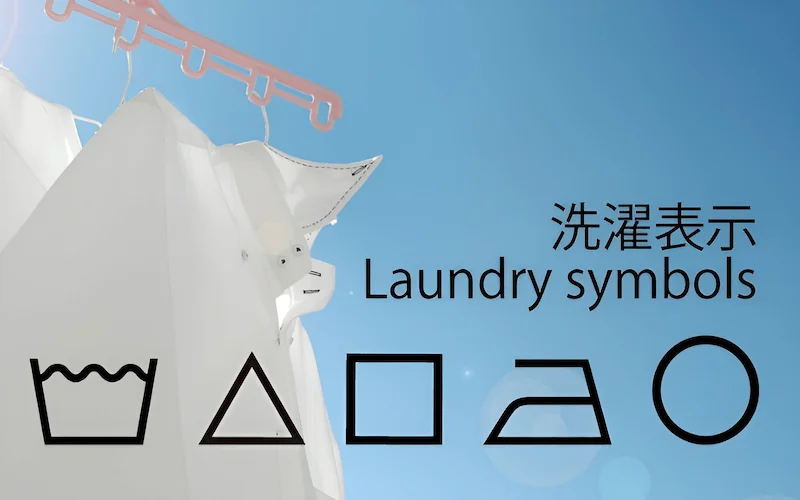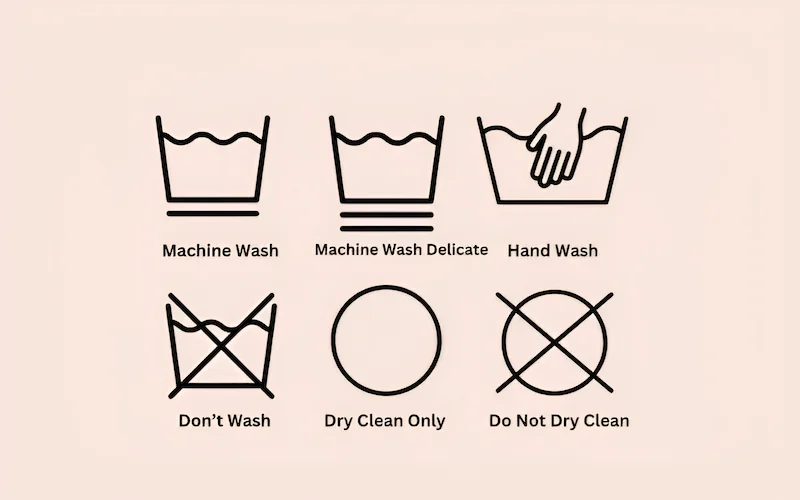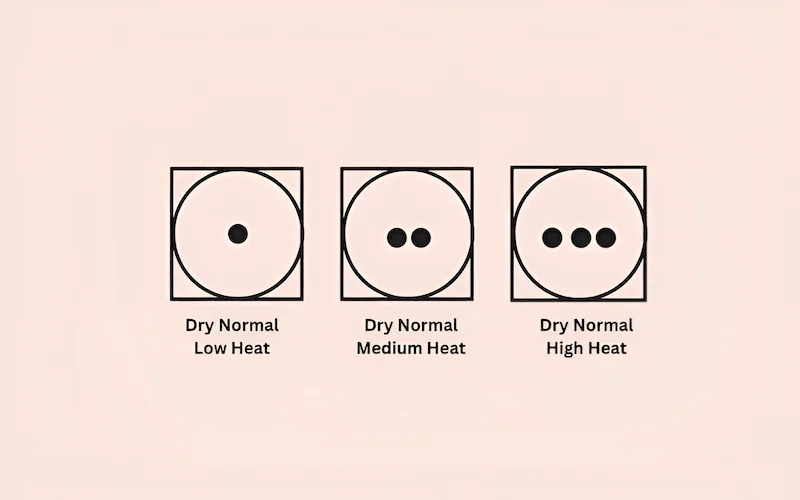Japanese Washing Labels Decoded: Symbols, Guide and Translation
Navigating the intricate world of clothing care can be tricky, especially when faced with unfamiliar Japanese washing labels. These symbols, while designed to be helpful, often leave individuals and businesses puzzled. This confusion can lead to improper garment care, resulting in shrinking, fading, or other damage, ultimately costing you time and money. Don’t let your favorite clothes become casualties of laundry mishaps!
If you’ve ever purchased clothing from Japan, imported garments, or run a business selling Japanese apparel, understanding these symbols is crucial. Incorrect laundering not only affects the lifespan of the clothing but can also create customer service issues and returns. Clear, accurate care instructions are essential for customer satisfaction and avoiding costly mistakes.
This guide is designed to demystify Japanese washing labels, which adhere to the JIS L 0001 standard. We’ll provide a complete breakdown of each symbol, its meaning, and how to apply it to your laundry routine. Empower yourself with the knowledge to confidently care for your garments and ensure their longevity, and create your own customized label.
1. Understanding Japanese washing label symbols (JIS L 0001)
1.1 The Evolution of Japanese laundry symbols
The care labeling system in Japan has a rich history, evolving to meet the needs of both consumers and the textile industry. Before December 2016, Japan used its own standard, JIS L 0217, for laundry symbols. However, to facilitate smoother international trade and easier understanding for global consumers, a significant change occurred. Japan adopted the JIS L 0001 standard, aligning its Japanese washing symbols with ISO standards.
This transition to international washing symbols meant a shift from uniquely Japanese pictograms to those recognized worldwide. This harmonization simplifies garment care for anyone purchasing Japanese textiles, regardless of their origin.
The history of Japanese textiles reflects a commitment to quality, and this standardization ensures consistent textile care instructions are communicated effectively. This makes the laundry symbols easier to understand and use.

1.2 The five basic symbol categories
Japanese care labels, under the JIS L 0001 standard, are built upon five core symbol categories. These provide a comprehensive guide to properly caring for your garments. The categories are: Washing, Bleaching, Drying, Ironing, and Professional Cleaning. Each category addresses a crucial step in the textile care process.
Washing symbols indicate whether an item can be machine washed, hand-washed, and the appropriate water temperature. Bleaching symbols specify which type of bleach, if any, is safe to use. Drying symbols provide guidance on tumble drying and natural drying methods.
Ironing symbols dictate whether ironing is permitted and at what temperature setting. Finally, dry cleaning symbols (or, more broadly, Professional Cleaning symbols) offer instructions for professional cleaners, including the suitable solvents. These care instructions are the key to preserving your clothes.
2. Decoding each Japanese washing symbol
2.1 Washing symbol (The Wash Tub)
The wash tub symbol is your primary guide for how to wash an item. The numbers inside indicate the maximum water temperature in Celsius.
Lines underneath the tub specify the wash cycle. No lines mean a normal cycle is suitable. One line indicates a gentle wash is needed, while two lines signify a very gentle wash. A hand inside the tub means hand wash only. An “X” through the tub means do not wash at home.

2.2 Bleaching symbol (The Triangle)
The triangle symbol dictates the rules for bleaching. A plain triangle means any type of bleach, including chlorine bleach, can be used. Japanese laundry labels are easy to understand, and these instructions will help you a lot in daily life.
Two diagonal lines within the triangle signify that only oxygen bleach is permissible. If the triangle has an “X” through it, do not bleach the garment under any circumstances. Understanding these bleaching symbols is crucial for preventing color damage.
2.3 Drying symbol (The Square)
The square is the key to understanding drying symbols. A circle inside the square means tumble dry is permitted. Dots within the circle indicate heat levels: one dot for low heat, two for medium heat, and three for high heat. An “X” means do not tumble dry.
Vertical lines inside the square mean line dry; horizontal lines, flat dry. Two diagonal lines in the upper-left corner indicate dry in shade. If these two lines are double, it is a drip dry.

2.4 Ironing symbol (The Iron)
The iron symbol governs ironing practices. Dots inside the symbol indicate the ironing temperature: one dot signifies low heat (80-120°C), two dots medium heat (140-160°C), and three dots high heat (180-210°C).
An “X” through the iron means do not iron. Following these ironing symbols carefully will help avoid scorching or damaging fabrics. Proper textile care ensures longevity.
2.5 Professional Cleaning symbol (The Circle)
The circle symbol provides instructions for professional cleaning. A “P” inside allows dry cleaning with perchloroethylene and petroleum-based solvents. An “F” indicates only petroleum-based solvents are permitted.
A “W” signifies wet cleaning is allowed. Lines underneath the circle indicate the cleaning intensity; more lines mean a gentler process. An “X” through the circle means do not dry clean. These dry cleaning symbols are vital for professional cleaners. Textile care at the professional level requires this knowledge.
3. Creating and ordering custom Japanese washing labels
3.1 Why use custom labels?
Custom washing labels offer numerous benefits for both businesses and individuals. For businesses, especially those importing or exporting clothing to or from Japan, these labels ensure compliance with Japanese regulations (JIS L 0001). Providing clear and accurate care instructions in the local language enhances customer satisfaction and reduces returns. They also improve branding and clothing labels in Japan.
Custom labels allow businesses to include their logos and other branding elements on garment tags. For individuals, textile labels are invaluable for replacing lost or illegible labels on cherished garments, or for adding professional-looking care instructions to handmade clothing. This ensures correct care and prolongs the life of valuable items.

3.2 Materials and printing options for washing labels
Choosing the right material is crucial for creating durable and effective washing labels. Woven labels, often made from polyester, are known for their exceptional durability and premium feel. Heat transfer labels offer a tagless solution, directly applying the design onto the fabric. We also offer rubber labels which are known for their 3D effect.
Printed labels on materials like satin offer a smooth, luxurious texture. Label materials each have their trade-offs; polyester is highly wash-resistant, while cotton provides a natural feel. Printing options like color printing can enhance visibility, while embossing adds a tactile element. These choices affect the label’s longevity and aesthetics.
3.3 Designing your labels: Size, shape, and information
Effective label design is paramount. Common label size and label shape choices vary, but clarity is key. Essential information includes care instructions (using JIS L 0001 symbols), fiber content (e.g., “100% Cotton”), and country of origin. Design your labels with a focus on legibility.
Choose an appropriate font size and ensure sufficient contrast between the text and background. Following these JIS L 0001 guidelines ensures your labels are both informative and compliant. Simplicity and clarity in care instructions are essential for effective communication.
3.4 Ordering your labels from PackLove
PackLove simplifies the process of acquiring custom Japanese washing labels. We offer a wide range of materials, printing techniques, design assistance, and a Value Booster Kit to maximize your brand. Our expertise in Japanese labeling requirements guarantees compliance and peace of mind.
Our streamlined ordering process involves selecting your desired materials, uploading your design, selecting your customize options, and approving a proof. We pride ourselves on fast turnaround times, competitive pricing, and a commitment to customer satisfaction.
4. FAQs about Japanese washing labels
4.1 What is the difference between JIS L 0217 and JIS L 0001?
JIS L 0217 was the former Japanese standard for washing symbols, used before December 2016. JIS L 0001 is the current standard, aligning Japanese symbols with international (ISO) standards for better global understanding and trade.
4.2 Can I use universal washing symbols instead of Japanese ones?
While JIS L 0001 aligns with international standards, using the exact JIS L 0001 symbols is crucial for garments sold in Japan. This ensures full compliance with Japanese regulations and avoids any potential consumer confusion.
4.3 What if my garment doesn’t have a washing label?
If a garment lacks a label, proceed with extreme caution. Test a small, hidden area with water and detergent before washing. Hand wash delicate items, and consult a professional dry cleaner for valuable or uncertain pieces.
4.4 How can I ensure my custom labels are compliant with Japanese regulations?
Compliance requires using accurate JIS L 0001 symbols, and including mandatory information like fiber content and country of origin. Partnering with a reputable label provider like PackLove, with expertise in Japanese labeling, guarantees accuracy.
4.5 Where can I find a complete chart of all Japanese washing symbols?
We provide a complete guide on the symbols on our website or you can check with official JIS L 0001 documentation.
5. PackLove – Providing service for Japanese washing labels
PackLove specializes in creating custom labels, with deep expertise in Japanese washing labels and JIS L 0001 compliance. We help businesses and individuals create accurate, high-quality labels that meet all regulatory requirements. We offer a variety of materials, including woven labels, heat transfer labels, and more.
Our printing options, combined with expert design assistance, ensure your labels are both informative and visually appealing. We understand the nuances of Japanese labeling, providing peace of mind and professional results. Design your perfect Japanese washing labels with PackLove!
Read more:
Understanding Japanese washing labels (JIS L 0001) is essential for proper garment care, protecting your clothing investment, and avoiding laundry mishaps. This guide has decoded the key symbols, empowering you to wash, bleach, dry, iron, and professionally clean your garments with confidence. Custom labels provide a valuable solution.
Accurate labeling benefits both consumers and businesses, ensuring compliance, clarity, and brand consistency. PackLove is your trusted partner for all your custom label needs, particularly for the Japanese market. Contact us today for any further assistance!






















